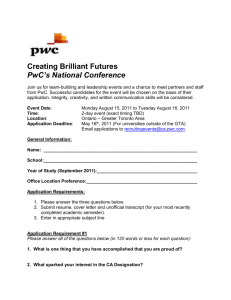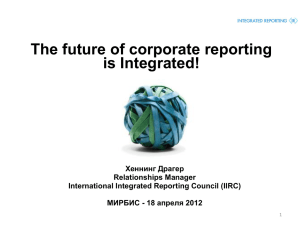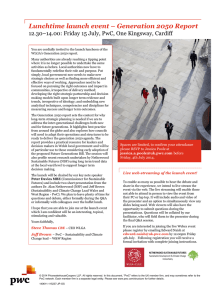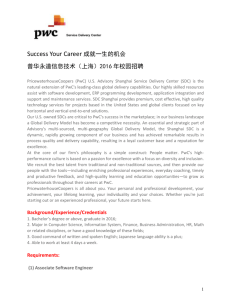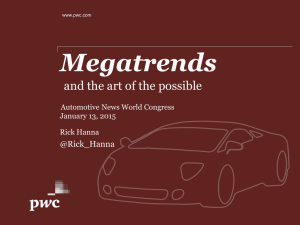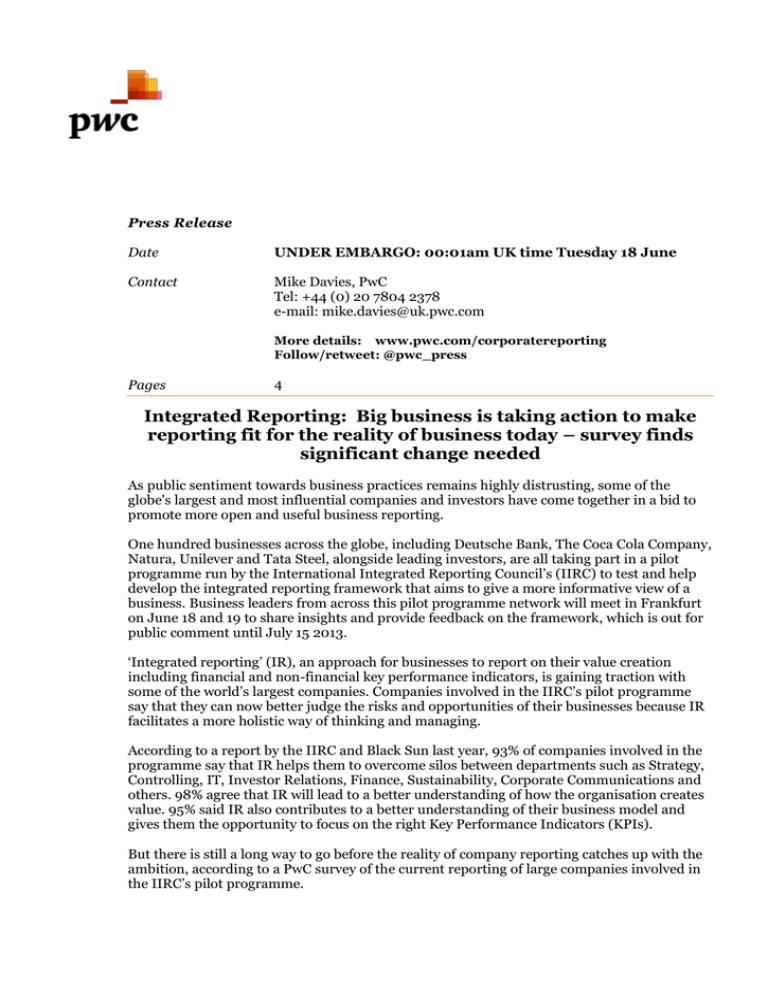
Press Release
Date
UNDER EMBARGO: 00:01am UK time Tuesday 18 June
Contact
Mike Davies, PwC
Tel: +44 (0) 20 7804 2378
e-mail: mike.davies@uk.pwc.com
More details: www.pwc.com/corporatereporting
Follow/retweet: @pwc_press
Pages
4
Integrated Reporting: Big business is taking action to make
reporting fit for the reality of business today – survey finds
significant change needed
As public sentiment towards business practices remains highly distrusting, some of the
globe's largest and most influential companies and investors have come together in a bid to
promote more open and useful business reporting.
One hundred businesses across the globe, including Deutsche Bank, The Coca Cola Company,
Natura, Unilever and Tata Steel, alongside leading investors, are all taking part in a pilot
programme run by the International Integrated Reporting Council’s (IIRC) to test and help
develop the integrated reporting framework that aims to give a more informative view of a
business. Business leaders from across this pilot programme network will meet in Frankfurt
on June 18 and 19 to share insights and provide feedback on the framework, which is out for
public comment until July 15 2013.
‘Integrated reporting’ (IR), an approach for businesses to report on their value creation
including financial and non-financial key performance indicators, is gaining traction with
some of the world’s largest companies. Companies involved in the IIRC’s pilot programme
say that they can now better judge the risks and opportunities of their businesses because IR
facilitates a more holistic way of thinking and managing.
According to a report by the IIRC and Black Sun last year, 93% of companies involved in the
programme say that IR helps them to overcome silos between departments such as Strategy,
Controlling, IT, Investor Relations, Finance, Sustainability, Corporate Communications and
others. 98% agree that IR will lead to a better understanding of how the organisation creates
value. 95% said IR also contributes to a better understanding of their business model and
gives them the opportunity to focus on the right Key Performance Indicators (KPIs).
But there is still a long way to go before the reality of company reporting catches up with the
ambition, according to a PwC survey of the current reporting of large companies involved in
the IIRC’s pilot programme.
The survey examined the reporting of 50 pilot companies that had already published reports
by April 30 2013. It was conducted by the integrated reporting specialists at PwC in
preparation for the two-day meeting they are hosting between the IIRC and global business
leaders that have already begun to work with the basic principles of integrated reporting in
their businesses. PwC is hosting the conference to facilitate sharing experiences with
integrated reporting and discussing examples of how they are applying the principles.
84% of the companies assessed already identify one or more non-financial
capitals material to their business operations. But so far only 15% comprehensively
report on all material capitals that are relevant to their industry and circumstances in their
2012 annual reports. When this is addressed it will be easier for stakeholders to see how
they are creating value from the resources used, and what impact that is having both on
the competitiveness of the business and the health of the communities they depend on.
In addition to information on financial and manufactured capital, the IIRC Framework
also calls for information on human, intellectual, social and relationship capital as well as
natural capital, if material to a company’s value creation.
About one quarter of the participants are already successful in
communicating how the business creates value.
Half of companies talk about what resources and relationships their business
models rely on. Of that 48%, the majority discusses constraints and availability
expectations – but very few companies cover all their material capitals in this way, and
even fewer support this with data. Reporting effectively on this would build confidence
that management has an accurate understanding of the risks to their business and
encourage investment.
83% discuss future market trends, but only 40% of those link market discussion to
strategic choices.
96% report their principal risks but only 23% integrate their risks into other areas of
their reporting – linking to strategy, business models and KPIs. Improvements here would
give more faith in how businesses are managing their risks and making appropriate
operational decisions.
71% of pilot companies explicitly identify their key performance indicators
(KPIs). About 47 % of businesses had some targets for these indicators, but only 17%
clearly align KPIs and strategic priorities; and only about a third of businesses make some
link between financial and non-financial performance.
As you might expect under current requirements, the majority does not yet
integrate their financial and non-financial performance in their reporting, which
suggests that there is some distance to go on building understanding within business
around how organisations create and destroy value (not just creating returns for their
shareholders), and further, how this affects their future prospects.
2 of 4
Richard Sexton, Global Assurance Leader elect at PwC, said:
“I believe integrated reporting is vital to properly communicate the way we do business
today, rather than 50 years ago. Without it, trust in business and our capital markets will
suffer, because investors and others will not have a clear picture of business – the risks
and the opportunities, the performance and prospects.
“It’s important for all of us to get started and make progress with integrated thinking and
reporting – but we have to remember that integrated reporting is in its early stages and
still being tested. Adopting the principles is a journey that should benefit businesses and
wider society as it builds trust in our capital markets.”
Paul Druckman, CEO of the IIRC, said:
“Corporate reporting is a key tool for communicating with stakeholders an organisation’s
unique story of value creation. The reality is that all too often businesses focus their
reporting on financial information alone, rather than the full and rich sources of value
creation, such as talent, knowledge and natural resources, the management of which are
critical to business success.
“The work to move towards integrated reporting is part of a broader move to re-establish
the confidence that enterprise can bring to our economy. It’s no coincidence that this
week’s G8 meeting, and the related G20 agenda, is focused on business transparency –
and that will be a focus for the next two years. Market-led innovation with integrated
reporting will help ensure that change achieves its ambition to re-energise capitalism and
doesn’t simply become another burden on business.”
Many businesses, not only the ones participating in the pilot programme, already use the
structure, content elements, and terminology of the integrated reporting framework as a
point of reference. Most businesses appreciate the competition among their peers as a driver
for the further development of their reporting. The benefits of IR that companies have
identified include:
Ends
3 of 4
Valuable insights into strategy and corporate management
Improvements to data quality and speed in collecting data
Efficiencies – preparing only one integrated report instead of several reports such as
an annual report and a sustainability report.
Notes
1. For more information, visit www.pwc.com/corporatereporting.
2. PwC helps organisations and individuals create the value they’re looking for. We’re a
network of firms in 158 countries with more than 180,000 people who are committed to
delivering quality in assurance, tax and advisory services. Tell us what matters to you and
find out more by visiting us at www.pwc.com.
© 2013 PwC. All rights reserved.
PwC refers to the PwC network and/or one or more of its member firms, each of which is a
separate legal entity. Please see www.pwc.com/structure for further details.
4 of 4



